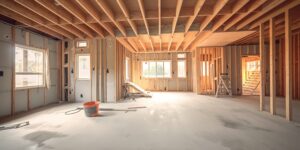 When the Ramdani family first laid eyes on their new home, it was clear they weren’t moving into a normal house. Instead of sharp corners and straight walls, the building had sweeping curves and rounded edges. Instead of wood framing and drywall, it was made of cement and polyurethane.
When the Ramdani family first laid eyes on their new home, it was clear they weren’t moving into a normal house. Instead of sharp corners and straight walls, the building had sweeping curves and rounded edges. Instead of wood framing and drywall, it was made of cement and polyurethane.
The world’s first 3D-printed home took just 54 hours to print and cost 20 percent less than an identical home built using traditional construction methods. Built as an experiment to test 3D printing as a viable method for home construction, it’s just one example of the many solutions builders have devised to address the affordable housing crisis. Skyrocketing building costs, a contracted labor market and epidemic land shortages have pushed home builders to innovate new building methods to help meet the intensifying demand for entry-level homes—and it’s about time, says John McManus, editorial and digital content director for the Residential Group at Hanley Wood in Washington, DC.
“Housing construction is ripe—and ready—for disruptive innovation if the current housing recovery cycle has any chance of lasting to 2020 and beyond,” he says.
But innovation goes hand-in-hand with risk. As residential construction projects become more complex and experimental, home builders risk opening the door to construction disputes with home buyers whose expectations may not align with cutting-edge home building techniques. With a flurry of construction innovation expected in the near future, it’s critical to embrace more sophisticated techniques for home builder risk management and claims avoidance, says Building Design & Construction.
Trends in global construction disputes
American builders, it seems, are getting savvier about minimizing the cost of home buyer complaints. As disputes around the world grew $10 million costlier, the average value of disputes in North America fell for the fourth consecutive year in 2017, from $21 million to $19 million. This could be due in part to the rise in third-party mediation and arbitration (versus expensive litigation) as a means of settling homeowner disputes. 
At the same time, however, construction disputes are taking longer to resolve. The amount of time it takes to settle a client complaint grew to nearly 18 months, far exceeding the global average, despite expert predictions that both the cost and duration would continue to decline.
“The average time it takes to resolve disputes continues to rise and is among the highest globally,” says the 2018 Global Construction Disputes Report. This begs the question: “Is the industry learning from its mistakes when it comes to disputes?”
Failure to properly administer construction contracts remains the most common cause of construction disputes worldwide, highlighting the need for better contract administration and more robust documentation—as well as the need for all customer-facing employees to become intimately familiar with the builder’s contractual obligations. Careful project planning, clear expectations, and early intervention to prevent issues from becoming full-blown disputes remain the most effective ways to head off costly claims.
“In an environment of labor shortages and increased pressure from expediting projects, it is often instinctual to focus on getting a project started first and dealing with consequences later,” the report states. “Even though many owners are fully aware that taking the time to administer a sound contract and negotiating clauses and terms are best practices, the results still show that failure to do so is an industry-wide problem.”
Benefits of third-party contract administration
Home buyers cite lack of proactive communication as one of their biggest sources of frustration with the building process—and it’s one builders can easily address by clearly outlining their home builder warranty terms and dispute resolution process in the initial sales contract. Yet too many builders continue administering their own new-home warranty. Without a team of home warranty experts at their disposal, they often make common errors in their contracts, such as:
- Using vague language like “reasonable” instead specifying limits or amounts.
- Setting unrealistic terms the builder is unable to meet.
- Adding too many restrictive provisions in an attempt to avoid punitive damages.
In an industry that runs on home builder reputation, management of builder home warranty claims can mean the difference between success and failure. A drawn-out home warranty dispute not only has the potential to destroy the already-slim profit margin on a given project, but it can also damage the builder’s credibility within the community. This is especially true as home builders increasingly stake their reputations on innovative approaches to residential construction that may result in unforeseen issues.
Whether you’re pioneering new building techniques or sticking with traditional methods, enlisting the help of a trusted third party is the most effective way to minimize both the cost and length of construction disputes. A third-party warranty partner such as PWSC can help builders manage risks by:
- Ensuring contracts and warranty documents are clear, specific and likely to be upheld in court.
- Empowering sales teams to set realistic expectations with home buyers.
- Administering all aspects of the builder home warranty to ensure a smooth, professional experience for everyone involved.
- Resolving home buyer disputes using the swiftest, most experienced and most cost-effective methods possible.
To tap into an eager market of entry-level buyers, today’s home builders must innovate new solutions to the affordable housing crisis. A third-party home builder warranty administrator like PWSC plays a critical role in managing the risks that come with pioneering great new ideas.




